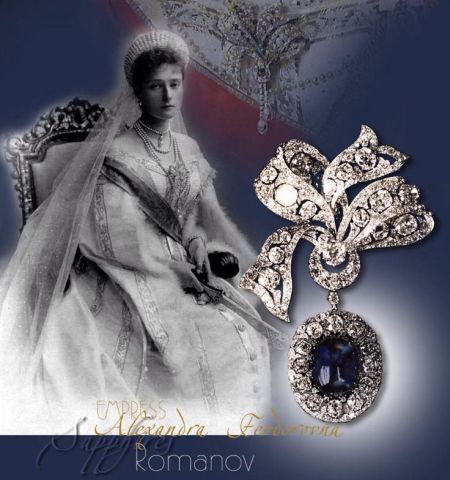This diamond „rayon diadem“ of Grand Duchess Maria Alexandrovna, comes from the jewelry collection of Empress Marie Alexandrovna, bequeathing it to her daughter.

This diamond „rayon diadem“ of Grand Duchess Maria Alexandrovna, comes from the jewelry collection of Empress Marie Alexandrovna, bequeathing it to her daughter.


When Fersman* listet the russian imperial jewels for sale, pos Nr 240 was discribed as
Imperial Sapphire and Diamond Bow Brooch of Empress Alexandra Feodorovna |Romanov

Update of the side of the year 2007 – the Imperial Gown is for sale in an auction house in Germany – klick for more information


The diamond and turquoise necklace is of stylised swag design, set with turquoise cabochons, highlighted with marquise, pear-shaped, brilliant circular single-cut and baquette diamonds. It was probably one of the private jewels of the Shahbanu Farah Diba.
It was seen when Farah Diba visited Emperor Haile Selassie of Ethiopia in 1968, at the state visit of Turkey and she wore it at the Near East Foundation dinner, in her honour, at the Waldorf Astoria New York in 1962 on the official visit of the Shah of Iran and his wife Farah Diba in America.
Above the Empress Farah, wife of the Shah of Iran, wears a large tiara with diamonds and pear-shaped turquoises and the matching pendant earrings. The parure, by Van Cleef and Arpels. had a larger turquoise and diamond necklace than the one in which the Empress is pictured above. Another tiara with smaller turquoises was sometimes worn by her.
The jewels of the Shah are deposited at the Bank of Iran, and they are owned by the state.
Thank you to Volker who provided me with this information.
The Earl of Southesk and his fiancée Camille Ascoli were married on, 5 September 2020. The Countess of Southesk wore the Fife Fringe Tiara, which had been on exhibition at Kensington Palace, since 2018. The diamond tiara was taken off display for the Carnegie wedding.
It was the wedding gift of Queen Alexandra and King Edward to their daughter the Princess Royal Louise, Duchess of Fife.
Charles „Charlie“ Duff Carnegie, Earl of Southesk, was born on 1 July 1989. He is the eldest of three sons of David Carnegie, 4th Duke of Fife, and his wife, the former Caroline Ann Bunting. Charlie Southesk is a great-great-grandson of King Edward VII.





::::::::::::::



::::::::::::::

Diamond Tiara Francesca Somerset Lady Caroline Georgina Somerset Wedding Diamond Diadem English Nobel Jewel History Duke of Beaufort

THE DAZZLING COLLECTION OF DORIS DUKE

Duchess Louise of Sachsen-Coburg-Saalfeld, Mother of Prince Albert the consort of Queen Victoria, in her silver wedding gown, when she married in 1817.
„……this afternoon there was great court and dinner.
During the festivities the bridal jewelry of the Duchess Louise was also on public display…. and a poem was written about it. … The princess’s bridal trousseau, whose value is estimated at 100 000 Thlr., was on public display in the castle on the 16th and 17th. Of rare beauty was the massive silver toilet with its golden contents, the velvet and silk richly embroidered dresses, the linen etc………….“
„The magnificent bridal jewelry, which was recently added by the princess aunt Grand Duchess Anna Feodorovna with a splendid brilliant necklace, was particularly outstanding.“
It could be the diamond belt and the border of diamond loops along the neckline. One counts, 17 entwined diamond rings and the other with 15 entwined smaller diamond ornaments.
An example of this, in the picture the link band of seven intertwined rings, set with approx. 722 diamonds in different historical cuts, as Peruzzi cut diamonds, Mazarin, pear shaped. Originally probably part of a tiara, which is also indicated by the mounting holes in the setting, which was sold a few years ago from a German ducal estate.
We see on the portrait of the Duchess Louise:
a diamond necklace with 9 drop pearls is still remarkable, as are the diamond and pearl earrings each with 3 large drop pearls. In addition, a diamond diadem of 14 visibly upright diamond ears and a diamond and pearl comb, behind it.
More history:


Maria Antonia Duchess of Parma, Infanta of Portugal. On 15 October 1884 at Schloss Fischorn, Maria Antonia married Robert I, Duke of Parma as his second wife. She was the mother of Empress Zita.
She is pictured with one of my favorite diamond tiaras.
Princess Irene of the Netherlands, did also wear the beautiful diamond Bourbon-Parma-Tiara, of the family of her husband. Some diamonds of the tiara are from the Duchess of Angoulême, daughter of Louis XVI and Marie-Antoinette, she left France in 1830 to Austria. It is said that the tiara was made in Vienna – probably by the court jeweler Köchert, like an older tiara once owned by the Duchess built in style of the XIX siecle by the jeweller of the French crown. The centerpiece is changeable.
This tiara belonged to the Bourbon-Parma family and had been deposed to a lawyer in Paris. Unfortunately it seems to have been lost actually since 1996. The Parma Tiara was trusted, at that time, to an attorney office in the late 90s by Princess Marie-Cécilie of Bourbon-Parma, while succession procedures took place. Mysteriously the tiara „got lost“ and the attorney office had to pay € 3.022.500 to the Bourbon-Parma family.
More history: